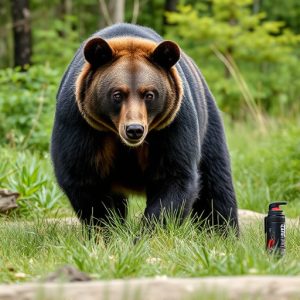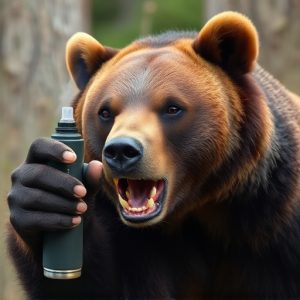Unraveling Bear Spray Cloud Dispersal Range: Factors & Best Practices
Understanding the Bear Spray Cloud Dispersal Range (up to 30 ft or 9 m) is crucial for hikers in bea…….
Understanding the Bear Spray Cloud Dispersal Range (up to 30 ft or 9 m) is crucial for hikers in bear country. Professional-grade sprays' effectiveness depends on factors like nozzle design, wind speed, terrain roughness, and bear species behavior. Best practices suggest aiming for direct contact with a bear's face and eyes within the optimal range of 20-35 feet (6-10 meters), maintaining calm, following safety instructions, and using proper application techniques to deter aggression. Early detection and distance maintenance are key; bear spray should be used as a last resort in aggressive encounters within this effective range.
“Unraveling the true potential of bear spray as a safety measure requires understanding its effective range. This article delves into the science behind bear spray cloud dispersal, exploring factors that influence its reach and impact. We analyze real-world scenarios and research to provide insights into optimal usage. By examining testing data, we uncover the best practices for maximizing protection when facing bears, ensuring safety within the confirmed effective range of bear spray cloud dispersion.”
- Understanding Bear Spray Cloud Dispersal Range: Factors Influencing Effectiveness
- Evaluating Real-World Scenarios: Testing and Research on Bear Spray Range
- Best Practices for Optimal Protection: Using Bear Spray Within Its Effective Range
Understanding Bear Spray Cloud Dispersal Range: Factors Influencing Effectiveness
Understanding Bear Spray Cloud Dispersal Range: Factors Influencing Effectiveness
The effectiveness of bear spray is closely tied to its cloud dispersal range, which refers to the area it can cover when sprayed. This range varies based on several factors such as the type of sprayer, spray pressure, and environmental conditions like wind speed and terrain. Professional-grade bear sprays are designed to create a dense, fog-like cloud that can extend up to 30 feet (9 meters) in ideal circumstances.
Key influences include the sprayer’s nozzle design, which determines the spray pattern and density of the cloud. Wind direction and speed can cause the spray to drift or dissipate more quickly, while rough terrain might break up the cloud, reducing its overall effectiveness. Understanding these factors is crucial for hikers and outdoor enthusiasts to make informed decisions about bear deterrents and ensure their safety in bear country.
Evaluating Real-World Scenarios: Testing and Research on Bear Spray Range
Evaluating real-world scenarios is essential in understanding the effectiveness and range of bear spray dispersal. Field tests conducted by researchers often involve simulating encounters with bears in diverse environments to assess the spray’s performance. These studies consider various factors, such as wind speed and direction, terrain, and the behavior of different bear species. By replicating these conditions, scientists can gather data on how far the bear spray cloud reaches and under what circumstances it is most effective.
Research has shown that the range of a bear spray cloud dispersal varies depending on several variables. Typically, professional-grade bear sprays are designed to project a mist or aerosolized liquid at high pressure, ensuring maximum coverage. Studies suggest that in ideal conditions, such as calm winds and open terrain, bear spray can be effective up to 30 feet (approximately 9 meters). However, factors like strong winds or uneven landscapes can reduce the range and stability of the spray cloud, potentially limiting its effectiveness.
Best Practices for Optimal Protection: Using Bear Spray Within Its Effective Range
To maximize the effectiveness of bear spray, it’s crucial to understand and adhere to best practices when using it within its optimal range. The bear spray cloud dispersal range typically varies between 20 to 35 feet (6 to 10 meters), depending on factors like the sprayer’s skill, wind conditions, and the specific product used. For the best results, users should aim for direct contact with the bear’s face and eyes from this distance, breaking up any aggressive behavior in its tracks.
When deploying bear spray, it’s essential to stay calm, follow safety instructions, and ensure proper application techniques. This includes holding the canister upright, activating the spray when at close range, and moving away quickly while allowing the cloud to disperse naturally around the bear. Remember, early detection of bears and maintaining a safe distance are key; using bear spray should be considered a last resort for self-defense against aggressive encounters within its effective range.
Bear spray is an invaluable tool for personal safety in bear-inhabited areas, but understanding its effective range is crucial. By factoring in variables like wind speed and direction, terrain, and spray type, users can maximize the deterrent’s potential. Research and real-world testing reinforce the notion that proper application within the optimal range significantly reduces bear encounters’ risk. Adhering to best practices ensures that bear spray remains a reliable defense, providing peace of mind while enjoying the outdoors.


